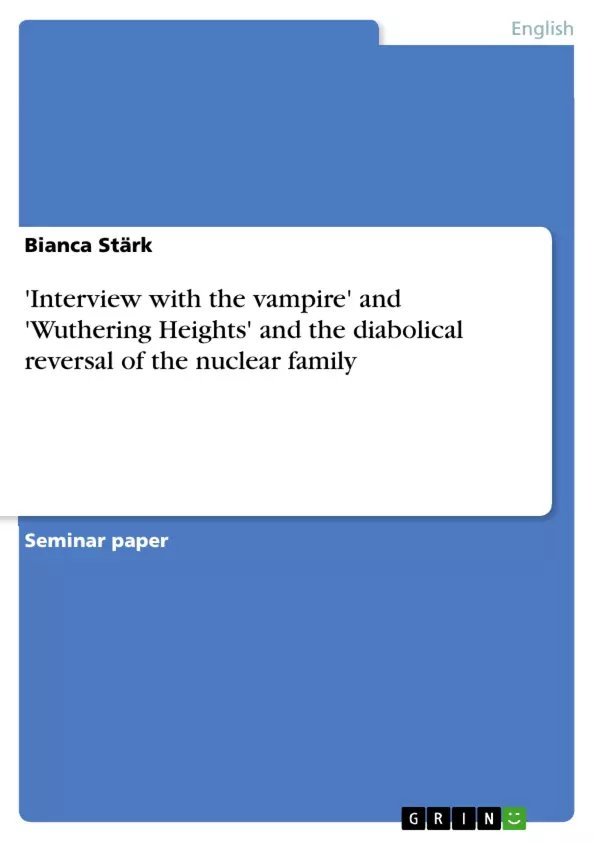Both novels are filed under Gothic fiction. Gothic always represents “otherness”. “Gothic fiction,…, frequently represents the ways in which both family and class, …, are threatened or attacked by the ‘dark forces’ of transgressive sexuality, illicit desires, and unsanctioned class mobility”(Niqi:1). The Gothic centre is “the realm of the family and the domestic and the class structures”(Niqi:2). Anne Williams argues that “the Gothic myth” (Williams: 22) is the patriarchal family. Gothic is determined by the rules of the family because family structure also generates the plots within Gothic. “Gothic plots are family plots, Gothic romance is family romance.” (Williams: 22)
In the English language plot also means “an area of ground” and therefore the “Gothic myth” has special kinds of settings. Not every story can take place in a haunted castle.
Inhaltsverzeichnis (Table of Contents)
- Interview with the Vampire and Wuthering Heights and the diabolical reversal of the nuclear family
- Gothic Fiction
- The Gothic Myth
- The Nuclear Family
- Interview with the Vampire
- The Vampire as the Other
- Louis and the Nuclear Family
- The Diabolical Reversal of the Nuclear Family
- Wuthering Heights
Zielsetzung und Themenschwerpunkte (Objectives and Key Themes)
This essay examines the theme of the diabolical reversal of the nuclear family in the novels Wuthering Heights by Emily Brontë and Interview with the Vampire by Anne Rice. The essay explores how these novels utilize Gothic conventions to present unconventional family structures and challenge traditional societal norms.
- The Gothic genre as a vehicle for exploring societal anxieties about family structures and transgression.
- The subversion of traditional family roles and dynamics through the representation of unconventional family units.
- The exploration of sexuality and desire outside of the confines of the nuclear family.
- The portrayal of the “other” and the outcast in Gothic fiction.
- The influence of the “Gothic myth” on the development of family plots and character relationships.
Zusammenfassung der Kapitel (Chapter Summaries)
The essay begins by introducing the concept of the diabolical reversal of the nuclear family within the context of Gothic fiction. It explores how Gothic literature often challenges conventional family structures and societal expectations.
The essay then focuses on Interview with the Vampire, analyzing how the vampire characters, particularly Louis and Lestat, form a diabolical family unit that defies traditional norms. The essay examines the vampire's role as an “other” and explores the themes of sexuality and transgression within the context of the novel.
Schlüsselwörter (Keywords)
This essay examines the themes of Gothic fiction, diabolical family structures, the nuclear family, the “other,” sexuality, transgression, and the Gothic myth. The essay utilizes examples from Interview with the Vampire by Anne Rice to illustrate these concepts.
- Arbeit zitieren
- Bianca Stärk (Autor:in), 2003, 'Interview with the vampire' and 'Wuthering Heights' and the diabolical reversal of the nuclear family, München, GRIN Verlag, https://www.grin.com/document/64267



